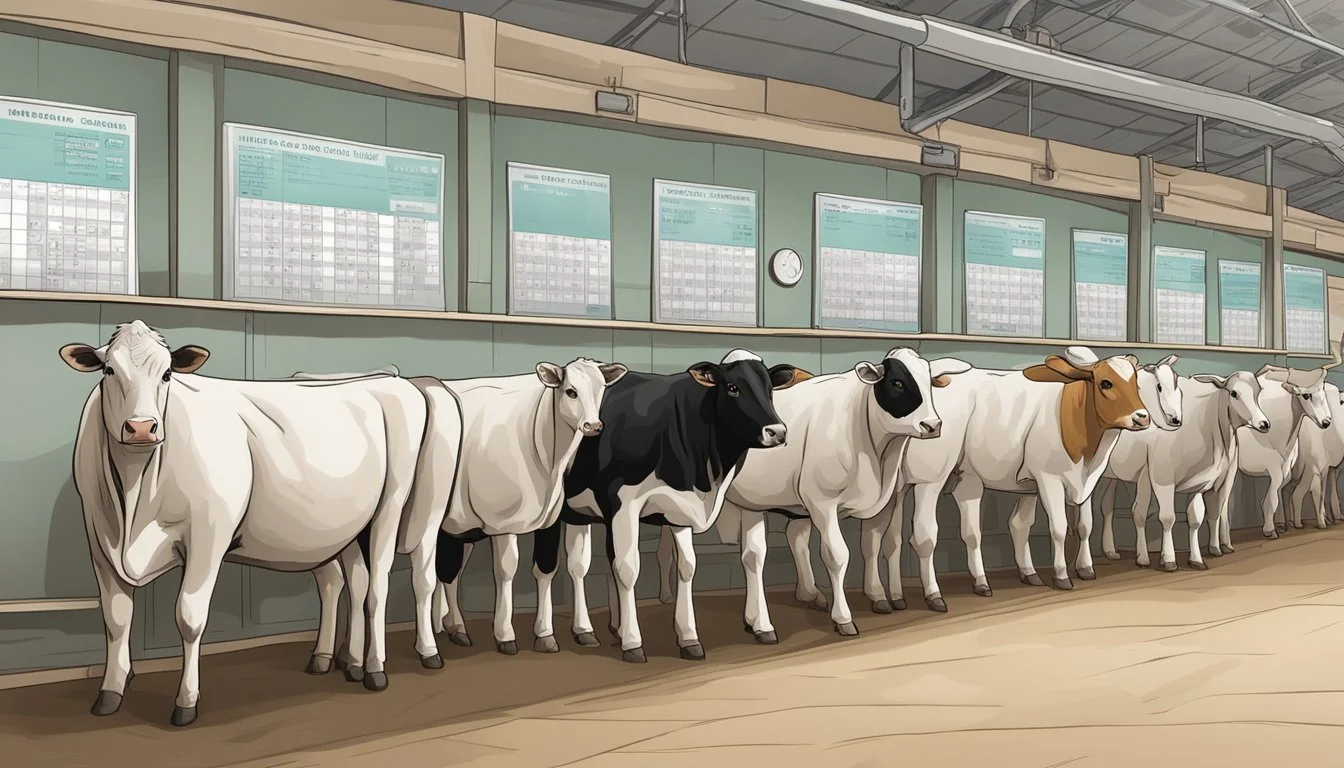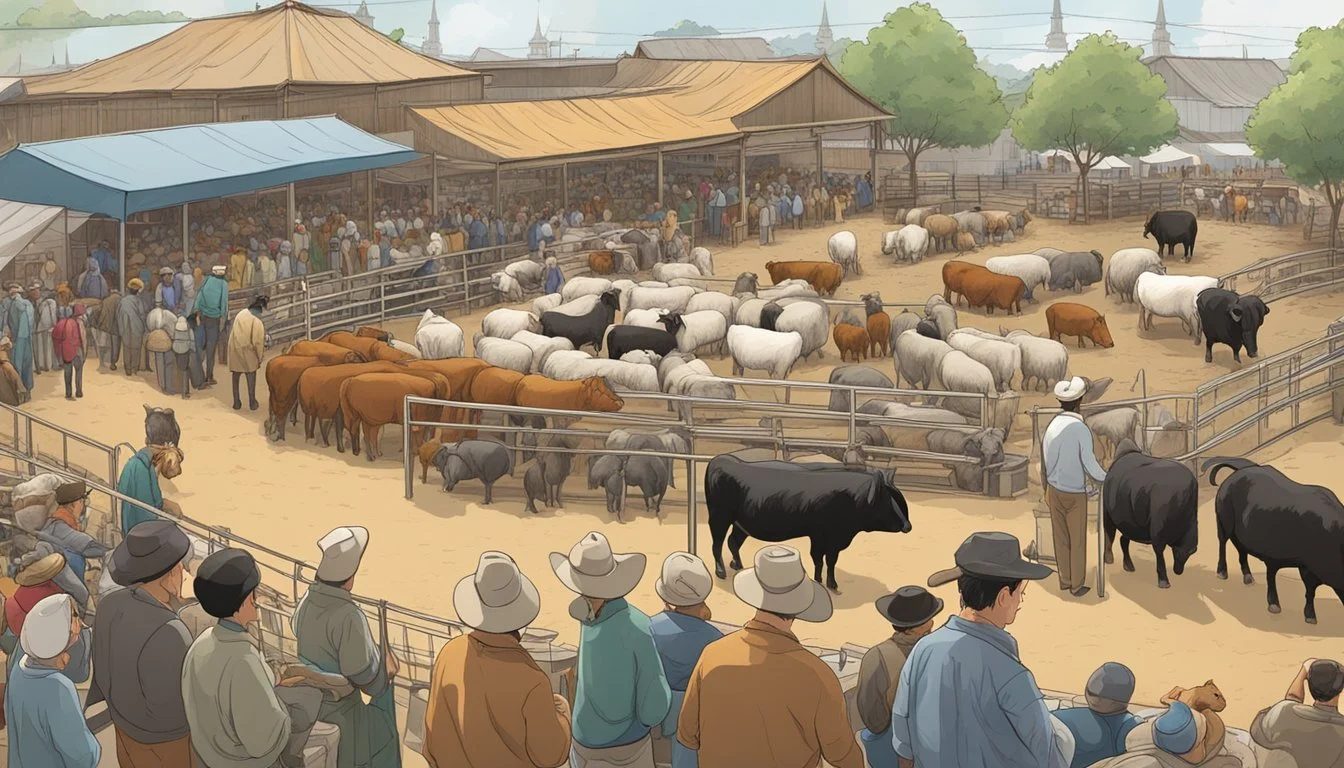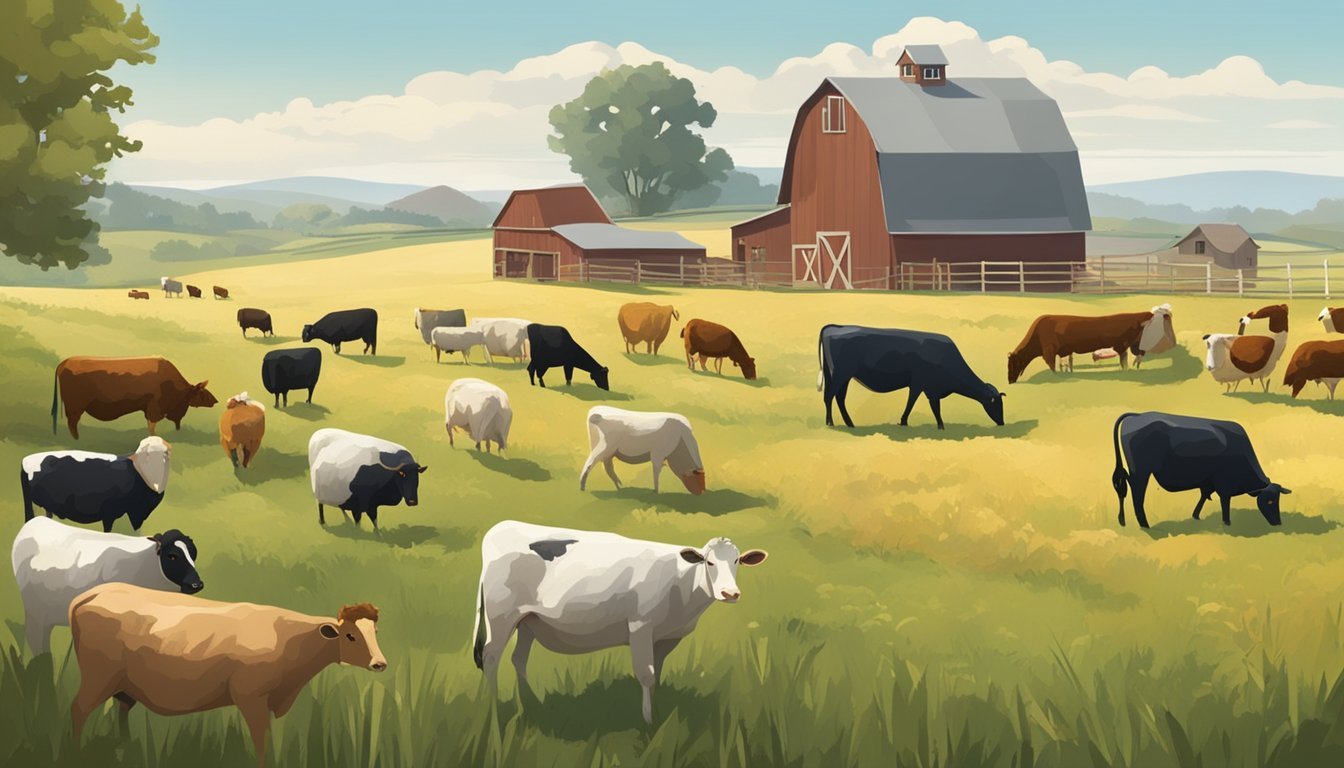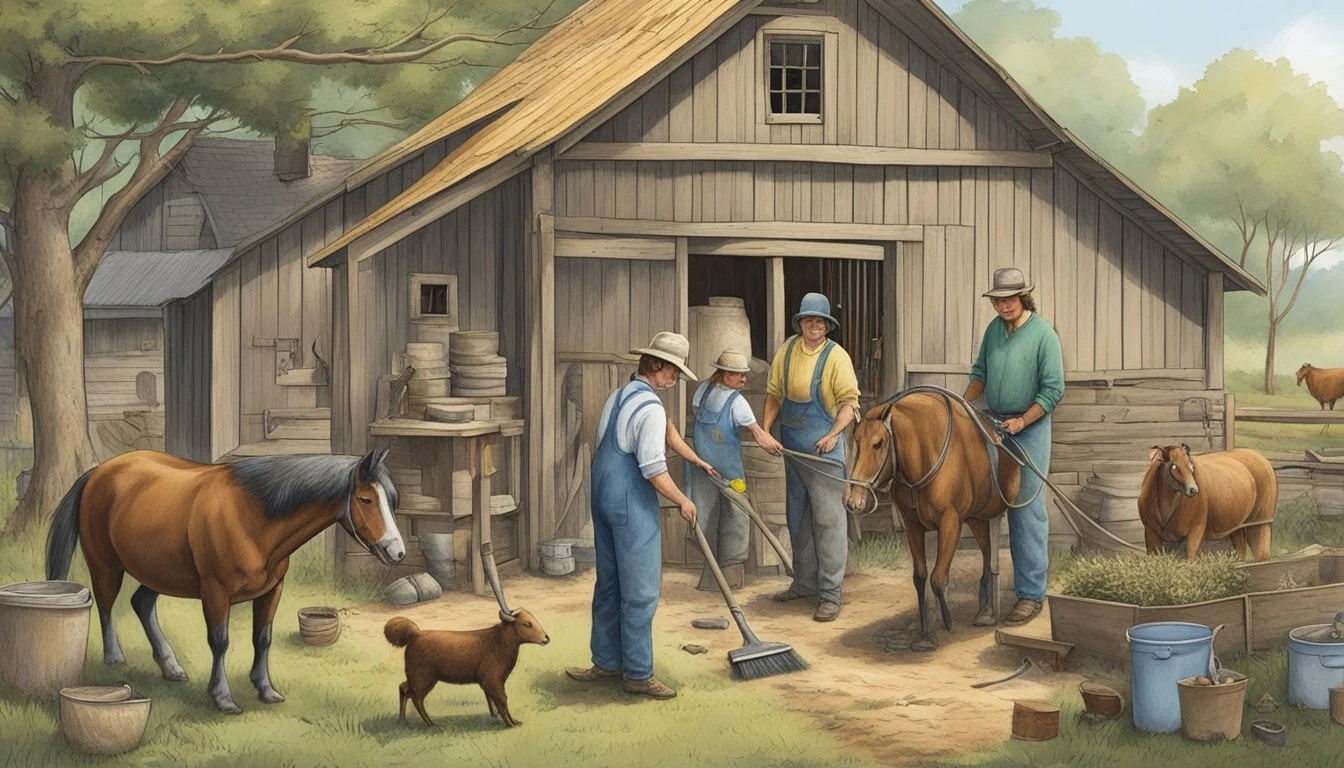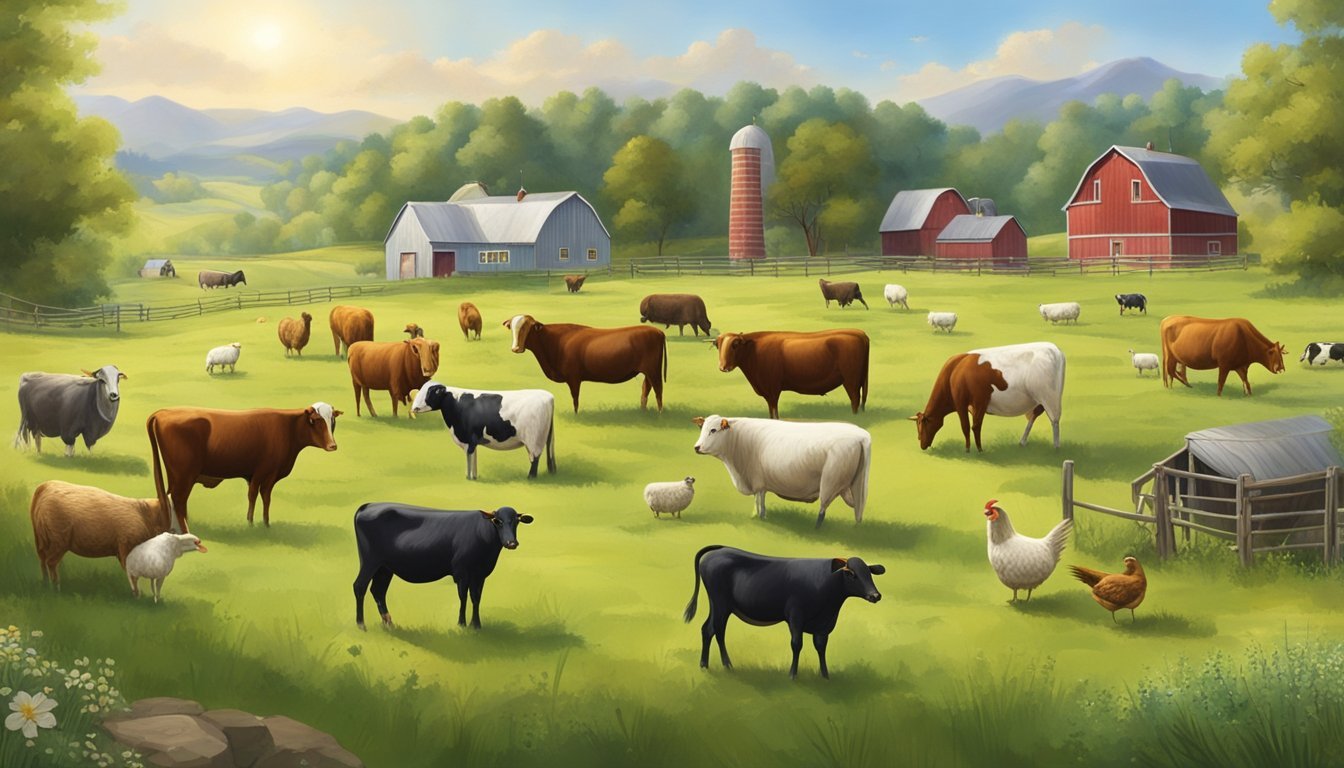The Ultimate Guide to Keeping Livestock Breeding Records
Key Strategies for Homesteading Success
Maintaining accurate breeding records is a cornerstone of successful livestock management on any homestead. These records provide homesteaders with invaluable insights into the genetics, health, and productivity of their animals. Detailed documentation encompasses the lineage, breeding dates, offspring outcomes, and health data which are essential for making informed decisions about future breeding pairings and managing resources efficiently.
By keeping systematic breeding records, homesteaders ensure the sustainability of their livestock programs. This practice allows for the tracking of genetic diversity, which is crucial in producing robust offspring and avoiding inbreeding. Additionally, well-kept records help in identifying the most productive breeding pairs, understanding fertility cycles, and improving overall herd quality.
Leveraging the use of modern digital tools aids in organizing this data effectively and simplifies the monitoring process. Digital records are not only easier to update, but they also improve accessibility and enable quick data analysis. Securely backed-up data ensures long-term record preservation, crucial when referencing historical breeding information for strategic decision-making on the homestead.
The Importance of Livestock Records
Livestock records play a pivotal role in enhancing farm management by providing a clear framework for decision-making and breeding efficiency. Keeping meticulous records enables farmers to advance their livestock productivity and sustain their operations effectively.
Understanding Record Keeping
Record keeping in the context of livestock involves the systematic documentation of information related to the entirety of farm activities, specifically breeding. Farm management software has revolutionized how farmers track breeding cycles, growth rates, and genealogies, providing a digital and efficient means of managing data. This transition to digital solutions allows for more accurate and easily accessible records.
Benefits of Accurate Records
Breeding: The maintenance of precise breeding records supports farmers in analyzing reproductive performance, thereby optimising the genetic progression of their herd or flock.
Health and Productivity: Detailed records expose patterns in livestock behavior and health that are critical for early disease detection and prevention, directly influencing productivity and longevity.
Financials: Through meticulous cost tracking included in record keeping, farmers gain insights into their operation's financial health, aiding in pricing strategies for better market competitiveness.
Key Record Keeping Principles
Consistency: Maintaining up-to-date records requires regular input. A robust system of consistent documentation ensures the most reliable data for analysis.
Accuracy: The integrity of farming decisions is only as strong as the accuracy of the records kept. Farmers should prioritize precision in recording details to avoid costly mistakes.
Accessibility: Records should be organized in a manner that they can be easily reviewed and interpreted for rapid decision-making.
By embracing thorough livestock record keeping, farmers streamline their operations, leading to improved efficiency and productivity. Breeding records, as a component of this practice, are specifically vital for sustainable livestock improvement and informed strategic planning.
Setting Up Your Record System
Setting up a livestock breeding record system is a fundamental step in homesteading that ensures meticulous management and traceability of animal lineage, health, and productivity.
Choosing the Right Medium
When selecting resources for keeping records, homesteaders must consider the ease of retrieval and the simplicity of data entry. Equipment can range from simple binders with divider tabs to sophisticated database systems depending on the scale of operations.
Digital vs Paper Records
Digital records offer advantages such as:
Easy to update and modify.
Search functionality for quick data retrieval.
Data can be backed up to prevent loss.
Paper records might be preferable for their:
Accessibility without the need for power or internet.
Ease of use for those less comfortable with technology.
Essential Features of Record Keeping Software
A good record-keeping software should have features such as:
Data Input Fields: For detailed entries about each animal, including tag numbers, and medical records.
Planning Tools: For scheduling breeding and vaccination dates.
Spreadsheet Integration: To allow for complex data analysis and reporting.
It is prudent to choose software that allows for easy data transfer from spreadsheets and other online data sources.
Privacy and Data Protection
Data protection should not be overlooked. Records often contain sensitive information that could be vulnerable to unauthorized access. Homesteaders should ensure:
Secured storage, whether using locked file cabinets or encrypted digital storage solutions.
Regular updates to security protocols, especially for software systems.
Restricted access to records, with contact details such as phone and email securely stored.
What to Record in Livestock Breeding
Accurate record-keeping is essential in managing a breeding program focused on productivity and animal welfare. Such records help in monitoring genetic diversity, disease resistance, and overall herd improvement.
Individual Animal Identification
Each animal on the farm should be identifiable with a unique tag or number. This facilitates tracking of its breeding history, age, health, and productivity over time. An individual record might include:
Tag number or microchip ID
Breed and sex
Date of birth or estimated age
Physical characteristics or markings
Breeding and Reproductive Data
Breeding and reproductive data is key to evaluating the effectiveness of breeding methods and the fertility of individual animals. Records should encompass:
Dates of breeding attempts
Identification of mating pairs
Expected and actual calving, lambing, or farrowing dates
Fertility rates and outcomes of breeding
Milk and Meat Production Records
Production records are indicative of an animal's value and its suitability for various roles. For milk and meat producers, notate:
Daily or seasonal milk yield
Milk quality parameters (fat content, protein levels)
Weights at various growth stages
Meat grade or quality at processing
Health and Welfare Monitoring
Health records are pivotal in managing and preventing illnesses. These records should track:
Vaccination and medical treatment history
Occurrences of diseases or illnesses
Interventions and recovery outcomes
Ongoing health and welfare assessments
Growth and Feed Efficiency
Measuring growth rate and feed efficiency aids in understanding the nutrition and feeding strategies needed for high productivity. Important data includes:
Weights at set intervals to calculate average daily gain
Feed type and feeding schedule
Feed consumption compared to growth
Adjustments in nutrition based on growth and health data
Successful livestock breeding relies on precise and comprehensive recording of each animal’s life cycle data. These records drive informed decision-making for health management, breeding strategies, and resource allocation, leading to a thriving homestead.
Management of Breeding Livestock
Effective management of breeding livestock is vital for a successful homesteading operation. It involves careful selection of animals, strategic planning of breeding programs, and integrating modern reproductive techniques.
Selecting Breeding Stock
In selecting breeding stock, it is essential to consider the genetic quality and health of the potential breeders. Desirable traits such as high fertility, good mothering abilities, and breed-specific characteristics should be prioritized. For example, selecting a dairy cow like the high milk-producing Holstein or the butterfat-rich Guernsey, or choosing robust Angus or Hereford cattle for beef production.
Traits for Dairy Cows: High milk yield, good udder health, longevity.
Traits for Beef Cattle: Efficient feed conversion, rapid growth, lean meat production.
Breeding Program Strategies
Breeding programs on homesteads must be designed to fit specific farming goals and market demands. This can involve purebreeding for maintaining a specific breed lineage or crossbreeding to combine desirable characteristics from two or more breeds. The timing of breeding must be managed to ensure optimal birth periods, aligning with fodder availability and market timings for maximum return on investment.
Purebreeding: Sustaining a particular breed, such as Hereford, by mating within the same breed.
Crossbreeding: Merging the traits of different breeds like Angus and Hereford for vigor in offspring.
Artificial Insemination and Genetics
Artificial insemination (AI) and genetic testing are modern tools employed in livestock management to enhance reproduction efficiency and genetic quality. AI allows breeders to use semen from high-quality bulls without the need for the bull to be physically present. This method can improve genetic diversity and limit the spread of disease. Homesteaders utilizing AI can carefully select genetic material from nationwide databases of dairy cow and beef profiles.
AI Advantages:
Increased genetic diversity
Elimination of the bull's presence, reducing safety and logistical issues
Access to superior sires otherwise unavailable.
Breeding livestock management on homesteads is a deliberate and precise process. By focusing on quality breeding stock selection, strategic breeding program development, and employing AI and genetic guidance, homesteaders can improve the productivity, health, and profitability of their livestock.
Nutrition and Feeding for Optimal Breeding
Proper nutrition is crucial for breeding livestock, impacting everything from fertility to milk production. This section outlines the feed types, dietary adjustments for breeding stages, and strategies to monitor costs and consumption effectively.
Feed Types and Nutritional Requirements
Feeding programs must meet the comprehensive nutritional requirements of breeding livestock, which include a balance of energy, protein, vitamins, and minerals to sustain health and reproductive efficacy. Specific feeds are designed to support different stages and performance goals of the animals.
Energy: Grains like corn and barley provide the necessary energy.
Protein: Soybean meal and legumes help meet protein needs for growth and milk production.
Vitamins & Minerals: Essential for preventing deficiencies and supporting overall health. For instance, calcium and phosphorus are critical for bull development.
Water is also indispensable, serving as a medium for nutrient transportation and metabolic processes. It should be provided ad libitum to ensure animals are well-hydrated, especially dairy cattle, as water directly influences milk yield.
Adjusting Diets for Breeding Phases
Adjusting diets according to the breeding cycle can maximize reproductive performance and offspring quality.
Pre-breeding: Increase nutrient density to support spermatogenesis and ovarian function around 61 days before breeding.
Gestation: Adapt the feed to maintain optimal body condition, avoiding overfeeding, which can lead to birthing issues and underfeeding that may affect fetal development.
Post-breeding: After conception, maintain a balanced diet to support embryo development and prepare females for lactation.
Careful ration formulation is necessary, accounting for the increase in nutrient demand during these critical phases.
Monitoring Feed Costs and Consumption
To optimize profitability, homesteaders should diligently track feed expenses and consumption rates.
Record expenses: Maintain a log of all feed purchases.
Analyze costs: Periodically review expenses to identify trends and potential savings.
Measure intake: Monitor how much feed each animal consumes to detect over- or underfeeding.
By refining feeding practices based on data, breeders can ensure animals receive the right nutrition while keeping a close eye on the bottom line.
Health Care and Vaccination Schedules
Effective livestock management is central to homesteading success, encompassing diligent health care and well-documented vaccination schedules. A robust record-keeping system is crucial to monitor animal health, manage treatments, and ensure timely vaccinations, fundamental to sustainable animal husbandry.
Routine Health Checkups
Regular checkups are pivotal for early detection of health issues, which can prevent costly treatments and loss of productivity later on. Livestock owners should record each animal's health checks, noting any changes in behavior, weight, and physical appearance. Recording such details aids in tracking health trends and making informed decisions on animal care.
Frequency of Health Exams: Biannual or more frequently depending on the species and production stage.
Key Health Indicators: Appetite, energy level, coat condition, body condition score, and presence of injuries or illnesses.
Managing and Recording Medications
It is essential to track all administered medications, from antibiotics to antiparasitic treatments. This information helps identify patterns in illnesses, effective treatments, and potential drug resistances. Administering medications requires precise dosage and timing; hence, meticulous records can assist in ensuring that each animal receives the appropriate care. Farm labor involved in administering medications should be adequately trained and should record:
Date of Administration
Medication Name
Dosage and Method of Administration
Withdrawal Periods (if applicable)
Name of Person Administering Medication
Vaccination Importance and Records
Vaccines are a critical component of preventive health care, equipping an animal's immune system to combat common pathogens. The importance of maintaining up-to-date vaccination records cannot be overstated. It enables producers to align with best practices in animal husbandry and meet legal requirements for disease control.
Preventive Disease Management: Vaccinations significantly reduce the incidence of diseases, contributing to overall herd health.
Vaccination Schedule:
Pre-breeding
Pre-lambing/weaning
Seasonal boosters as necessary
Record-Keeping Essentials:
Animal Identification
Vaccine Type
Date Administered
Next Due Date
Administrator
Thorough records streamline the vaccination process, allowing for the anticipation of vaccine needs and timely administration, ensuring optimal herd immunity and productivity.
Facilities and Environment for Breeding Livestock
For successful livestock breeding, optimal facilities and environment are crucial. They must cater to the specific needs of each type of livestock, ensuring adequate space, comfortable housing, and a clean setting to promote health and productivity.
Space and Housing Requirements
Goats:
Space: Require about 10-20 square feet per goat indoors, and 200-500 square feet per goat outdoors.
Housing: Should have dry, draft-free shelters with proper fencing to protect from predators.
Chickens:
Space: An average of 2-3 square feet per chicken inside a coop, and 8-10 square feet in an outdoor run.
Housing: Coops must be ventilated, insulated, and have nesting boxes with easy access for egg collection.
Horses:
Space: At least a 12x12 foot stall per horse; paddocks should provide enough room for free movement and exercise.
Housing: Stables should be well-ventilated, with a dry and comfortable resting area and room for socialization.
General Space Considerations:
Ensure there is enough room for animals to move, rest, and exhibit natural behaviors.
Adequate space reduces stress and the risk of disease transmission.
Outdoor areas should provide shade and protection from adverse weather.
Maintaining a Safe and Clean Environment
Cleanliness: Regular removal of manure and soiled bedding is essential to prevent disease and pests.
Climate: Structures must offer protection from extreme temperatures, whether it be heat or cold.
Hay and Feed Storage: Keep in a dry, pest-free area to prevent spoilage and contamination.
In Relation to Gardens:
Proper space allocation is necessary to prevent livestock from encroaching on garden areas.
Manure management must be practiced to ensure garden areas are not adversely affected.
By providing tailored space and housing that accounts for the specific needs of goats, chickens, horses, and more, breeders can create an environment conducive to the animals' well-being. Along with climate considerations and a stringent cleanliness regime, a homestead can successfully support a thriving breeding program.
Financial Management in Livestock Breeding
Effective financial management is crucial in livestock breeding as it allows breeders to monitor the cost-effectiveness of their operations and make informed decisions that affect the bottom line.
Budgeting for Your Breeding Program
A well-structured budget is the foundation of any successful breeding program. It outlines the anticipated expenses and income, guiding the breeder in resource allocation. Expenses can include feed, veterinary care, labor, and infrastructure, while income typically comes from the sale of animals and products. Breeders should categorize their budget into fixed and variable costs to better understand their financial commitments.
Tracking Expenses and Income
Accurate record-keeping of all financial transactions enables breeders to track their expenses and income effectively. This may involve using livestock management software to record and categorize every purchase and sale. Regularly updated records ensure that breeders have real-time access to their financial status, which aids in operational adjustments when required.
Category
Feed and Nutrition
Veterinary Services
Sales of Livestock
Fertility Programs
Expenses ($)
2,500
800
0
1,200
Income ($)
0
0
6,000
0
Economic Analysis of Breeding Operations
To ensure the profitability of livestock breeding efforts, breeders should conduct an economic analysis of their operations. This involves evaluating the return on investment for each animal, considering both direct and indirect costs related to their breeding program. Tools like break-even analyses and profitability indexing can help breeders optimize their operations for better financial outcomes.
Maximizing Productivity and Efficiency
In livestock breeding, achieving high productivity and efficiency is paramount for successful homesteading. The focus is on optimizing meat and milk production through precise assessment and the integration of modern technology.
Assessing Performance and Productivity Metrics
Assessing the performance of livestock involves measuring production variables such as milk yield and weight gain systematically. This evaluation utilizes productivity metrics that can be tracked using:
Milk Production: The quantity of milk produced can be captured using a dairy herd management software, updated at every milking session.
Meat Production: Weight scales are used to monitor growth rates, with data recorded and analyzed to understand meat yield efficiency.
Livestock producers can employ efficiency calculators to gauge the input-output ratio, giving insight into areas that require improvement.
Improving Efficiency Through Technology
Modern technology facilitates more efficient livestock farming, with tools designed to enhance the productivity of the herd:
Automated Feeders: These ensure animals receive the optimal amount of nutrients tailored to boost growth and milk production, thereby improving efficiency.
Health Monitoring: Wearable technology can detect early signs of illness, allowing swift intervention and minimizing impacts on meat or milk efficiency.
Employing such technologies allows producers to systematically evaluate their livestock, ensuring data-driven decisions that enhance overall herd productivity.
Navigating Market Trends and Demands
Keeping meticulous breeding records can greatly impact a farm's ability to adapt to changing market trends and consumer demands. These records contribute to strategic decision-making regarding milk and meat production.
Understanding Market Dynamics
Market Reports: Regularly consulting USDA market reports—such as the Livestock and Poultry Outlook—allows farmers to gain insight into current trends in cattle numbers, which can influence breeding decisions. A decrease in the number of calves, as reported in early 2023, could suggest an upcoming decline in supply that may affect prices.
Economic Indicators: Tracking economic indicators helps breeders anticipate shifts in meat and milk production profitability. Factors such as feed costs, consumer spending power, and global trade policies all sway market dynamics.
Marketing Breeding Livestock
Target Audiences: Success often lies in identifying the right audience for breeding livestock. Whether targeting large-scale operations or local homesteaders, understanding their needs guides which traits to prioritize in breeding programs.
Highlight Traits: Emphasize animals with desired traits in marketing efforts, such as disease resistance or growth rates. Focus on qualities that resonate with current market demands.
Promotional Strategies:
Create detailed lists of pedigree and performance data to share with potential buyers.
Leverage online agricultural platforms for wider exposure.
Adapting to Consumer Preferences
Health and Quality Standards: As consumers increasingly value animal welfare and product quality, breeding records that demonstrate high standards can command premium prices.
Trend Responsiveness: Farmers must remain agile, adapting breeding strategies to reflect consumer preferences, such as a demand for organic milk or grass-fed beef. This requires not only careful record-keeping but also a deep understanding of breeding principles to ensure that the stock meets these specific market niches.
Preference Shifts:
Milk Production: Incorporate breeding techniques that may improve milk yield or quality, catering to health-conscious consumers.
Meat Production: Align breeding practices with consumer preferences, for instance selecting for traits that enhance marbling or lower environmental impact.
By attentively monitoring market trends and consumer demands, homesteaders can make informed breeding decisions to optimize profitability and meet the market where it stands.
Role of Extension Services and Community
In successful livestock breeding, the role of extension services is pivotal, offering resources and knowledge sharing platforms that homesteaders can leverage. Community interaction further thrives on collective experience, enhancing breeding outcomes.
Utilizing Extension Office Resources
Extension offices serve as crucial hubs for homesteaders to access a range of resources necessary for maintaining accurate breeding records. They provide:
Educational materials: Guidelines on best practices for recording lineage, productivity, and health data.
Training sessions: Workshops conducted by experts to teach farmers the systematic approaches to animal identification and performance tracking.
Farmers can turn to these offices for the latest scientific insights and technical support, ensuring that their record-keeping is both up-to-date and precise.
Engaging with Local Farming Communities
The local farming community constitutes an essential support system for livestock breeders. Farmers can benefit from:
Networking events: To connect with peers and discuss breeding strategies.
Community breeding programs: Initiatives that promote systematic breeding practices and collective management of genetic resources.
By participating in community-based programs, homesteaders can immerse themselves in a shared pool of knowledge and experiences which can be instrumental in refining their record-keeping methods.
Sharing Knowledge and Experiences
In the collective spirit, community-based breeding programs often encourage the sharing of knowledge and experiences. This involves:
Performance data sharing: Useful for comparative analysis and community-wide improvement.
Success stories and challenges: Providing a real-world context that can guide new and existing farmers.
Through the dispersion of this information, homesteaders not only enhance their own practices but also contribute to the success and innovation within the broader livestock breeding community.
Advances in Animal Husbandry
The integration of technology and a deepened understanding of genetics have revolutionized animal husbandry. These advancements not only refine breeding strategies but also play a vital role in ensuring genetic diversity and conservation.
Emerging Breeding Technologies
In the realm of animal husbandry, technology has ushered in a new era of breeding efficiency and precision. Farmers and breeders now utilize sophisticated software systems designed to manage and analyze extensive breeding records. These systems enable them to track breeding activity and monitor the return on investment for each animal. Health and growth metrics can be measured accurately, which substantially enhances decision-making. Additionally, automation technologies have made it possible to streamline processes such as feeding, milking, and monitoring animal health, thereby increasing overall farm productivity.
Notable Technological Tools Include:
Automated Milking Systems (AMS): They permit cows to be milked on demand while collecting valuable data on milk yield and quality.
Radio-Frequency Identification (RFID) Tags: These tags store and track data on individual animals, enabling easy identification and health monitoring.
Genetic Testing Kits: Such kits aid in preemptively identifying potential hereditary diseases and traits, thereby informing breeding decisions.
Understanding Genetic Diversity and Conservation
The importance of genetic diversity in animal husbandry cannot be overstated. It is the foundation for maintaining a healthy and resilient livestock population. Breeding programs are now informed by genetic mapping and analysis, which help identify and conserve important genetic traits within livestock species. Strategies are employed to prevent inbreeding and to maintain a diverse gene pool, which is essential for the survival and adaptability of species in changing environmental conditions.
Strategies Include:
Selective Breeding: Focusing on animals with desirable traits to ensure these are passed on to future generations.
Crossbreeding: This introduces new genetics into a breeding pool, which can improve health and vitality.
Gene Banks: Collections of genetic material (semen, eggs, DNA) from diverse breeds are stored to safeguard against loss of genetic diversity.
Through these methods, conservation of genetic diversity is prioritized, ensuring the long-term viability of livestock breeds. These proactive approaches in animal husbandry help to maintain ecosystems and support sustainable farming practices.
Daily Operations in Homesteading
Efficient daily operations are crucial for the successful management of a homestead. They require consistent attention to detail and a regimented schedule to maintain the health and productivity of livestock.
Record Keeping Routines
Every day, homesteaders should diligently update their livestock breeding records. This daily log should include:
Health observations: Noting any changes in appetite, behavior, or appearance.
Breeding data: Recording mating occurrences, expected due dates, and lineage.
Milk production: For dairy animals, tracking daily milk yield is important.
Growth records: Regular weigh-ins for young animals to monitor growth rates.
Feed consumption: Detailed accounts of feed types and amounts consumed.
These records are typically maintained in a dedicated farm management software or physical logbooks. Regular, timely entries help homesteaders make informed decisions about breeding programs, health interventions, and operational adjustments.
Handling Calving and Other Key Events
Key events such as calving require meticulous planning and labor management.
Checklist: A pre-calving checklist should be in place to ensure all necessary supplies are on hand (e.g., colostrum, iodine, clean bedding).
Labor: Labor needs to be scheduled around expected calving dates to handle the increased workload.
During Calving:
Monitoring: Close monitoring of labor signs and the calving process to intervene if necessary.
Records: Immediate recording of the calving details, calf health, and any interventions required.
Post-Calving:
Health Checks: Regular check-ups on the mother and calf, noting any concerns in the health record.
Updates: Updates to breeding records to reflect the outcome of the calving event and plan future breeding.
Throughout these stages, a systematic approach ensures that both the livestock and the homesteader are prepared for a successful calving event. This preparation, coupled with precise documentation, establishes a foundation for maintaining robust animal husbandry practices.
Raising Various Livestock
In managing livestock, understanding the unique needs and best practices for each animal type is crucial for a thriving homestead. This section will explore targeted strategies in raising goats, dairy cows, and poultry to ensure health and productivity.
Challenges and Tips for Raising Goats
Raising goats can be both rewarding and challenging due to their curious and escape-prone nature. Goats require secure fencing to prevent wandering and protection from predators. Nigerian Dwarf goats, a popular dairy breed, are known for their manageable size and high butterfat milk production. To support their health and breeding success:
Provide a balanced diet rich in nutrients.
Maintain a regular deworming and vaccination schedule.
Ensure adequate shelter from weather extremes.
Best Practices for Dairy Cow Management
Dairy cows demand attentive management for optimal milk production and reproductive health. The cornerstone of dairy farm success revolves around stringent record-keeping and regimented schedules. For efficient dairy cow management:
Keep meticulous records of breeding, milk yield, and health interventions.
Implement a consistent milking routine to maximize production.
Provide high-quality feed and clean water to enhance milk quality.
Insights on Poultry Farming
Raising chickens is a starting point for many homesteaders due to their relatively low cost and quick return on investment through egg production or meat. However, to manage a productive flock, one must:
Protect chickens from predators with secure housing.
Monitor for signs of illness or distress for timely intervention.
Use proper lighting to stimulate egg production in layers.
By embracing these tailored approaches, homesteaders can achieve successful livestock management across varying breeds and animal types.
Supplementary Records for Homesteading
In addition to livestock breeding records, thorough homesteaders maintain supplementary records that encompass garden productivity, equipment inventory, and visual documentation. These records provide an integral data set for improving operational efficiency and tracking homestead progression over time.
Garden and Crop Records
Location of plant beds
Type of plants in each bed
Date of seed sowing
Date of transplanting seedlings
Quantity harvested per plant species
Harvest dates
Growth Observations:
Notable growth milestones
Effects of weather patterns on growth
Soil Amendments:
Type of amendment used
Dates of application
Equipment and Infrastructure Inventory
Tools and Machinery:
Name and description of each item
Purchase date and price
Last serviced date
Upcoming maintenance
Description of structures (e.g., coop, greenhouse)
Construction or purchase date
Repairs and Upgrades:
Details of recent repairs
Planned improvements
Photo and Video Documentation
Photographic Records:
Images of plant progression
Before-and-after shots of garden layout changes
Video Logs:
Clips showing equipment in use
Timelapse videos of crop growth rounds
Visual Health Checks:
Close-ups of plants for disease identification
Videos for tracking animal behavior changes
By ensuring these records are detailed and well-maintained, homesteaders can gain insights into their garden's productivity, maintain a current inventory of their equipment, and visually document changes and progress—all of which are vital for informed decision-making and successful homestead management.
Troubleshooting Common Issues
In the realm of livestock breeding, a successful homesteader must be adept at identifying and resolving issues concerning fertility, feed, nutrition, and health. These common challenges require prompt attention and informed strategies to ensure the wellbeing of animals and the productivity of the homestead.
Addressing Fertility Problems
When faced with fertility issues, it is essential to monitor breeding patterns and cycles closely. A homesteader might consider:
Recording breeding dates: Marking down the exact dates of breeding can help pinpoint potential fertility issues if conception does not occur.
Consulting with a veterinarian: Regular check-ups can reveal underlying health conditions affecting fertility.
Key factors affecting fertility:
Age and weight of the livestock: Ensure breeding animals have reached optimal weight and maturity.
Breeding season: Align breeding activities with natural fertility cycles of the animals.
Dealing with Feed and Nutrition Challenges
Feed and nutrition are the cornerstones of healthy and productive livestock. An effective feeding strategy includes:
Calculating proper intake: Adjusting feed quantities based on animal age, weight, breed, and pregnancy status.
Balancing nutrients: Providing a diet that contains a suitable balance of proteins, carbohydrates, fats, vitamins, and minerals.
Noteworthy nutrition considerations:
Quality of feed: High-quality feed contributes to better disease resistance and overall animal health.
Seasonal changes: Alterations to dietary needs may be necessary to counteract seasonal fluctuations in forage quality and availability.
Preventing and Managing Health Issues
Active prevention and management of health issues are crucial in maintaining a thriving livestock population. Homesteaders should:
Implement a vaccination schedule: Prevent communicable diseases with routine vaccinations.
Monitor for signs of illness: Keep a vigilant eye on the herd for any behavioral changes, signs of distress, or symptoms of disease.
Effective health management practices:
Quarantine new arrivals: Isolate new animals before introducing them to the herd to prevent the spread of potential diseases.
Record keeping: Meticulously maintain health records to track any patterns or recurring issues over time.
Conclusion
Maintaining detailed livestock breeding records is a pivotal component of homesteading success. The meticulous tracking of each animal's lineage, health, and productivity can significantly aid homesteaders in making educated decisions for their operations. By embracing a structured approach to record-keeping, one ensures a clear understanding of an operation's trends and outcomes.
Key benefits of rigorous record management include:
Informed Breeding Decisions: Picking superior traits becomes straightforward.
Health Surveillance: Early detection and prevention of disease spread.
Financial Transparency: Insight into the economic aspects of breeding programs.
Homesteaders are encouraged to integrate digital tools to streamline the process, allowing for efficient sorting, updating, and analysis of data. Regular recording schedules should be established to keep information current and actionable.
To recap, diligent record-keeping practices lead to:
Enhanced breeding outcomes.
Optimal livestock health.
Economic efficiency.
Lastly, the continuity of data over time provides invaluable insights for both current and future breeding efforts. It equips one with the foresight to refine strategies, contributing to a robust and thriving homestead.




